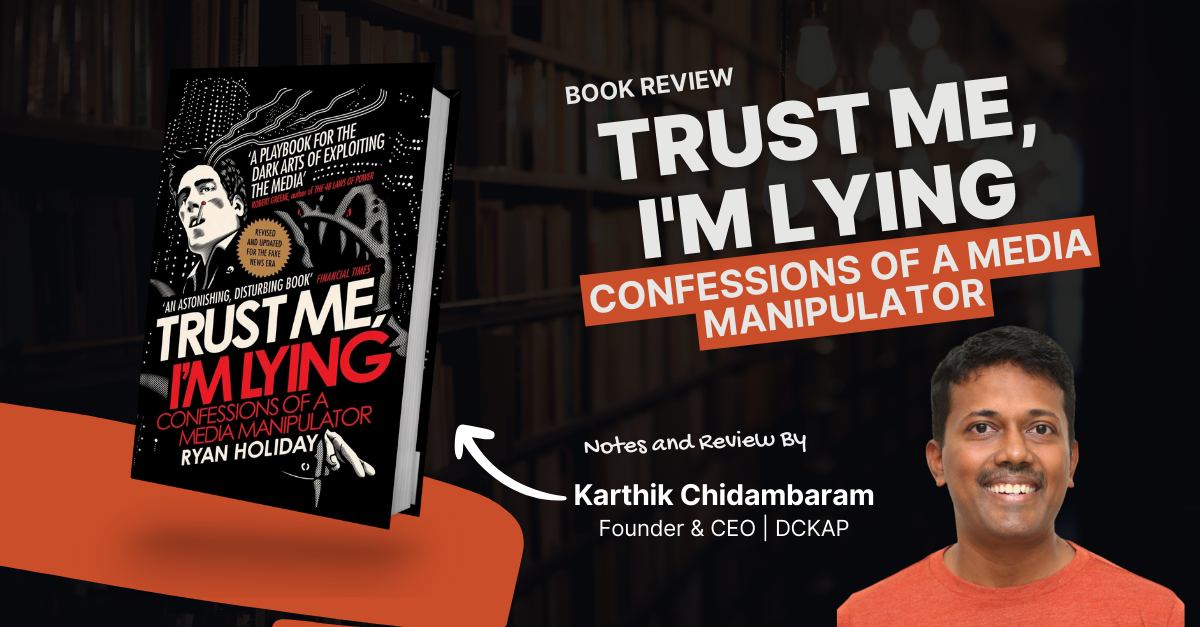Trust Me I’m Lying’ by Ryan Holiday – A Quick Summary
When I was watching this Tim Ferris podcast with Sam Corcos – an ultimate guide to virtual assistants, 10x Delegation, and more, this book – Trust Me, I’m Lying by Ryan Holiday was referenced. During the podcast, Sam Corcos mentions that he stopped watching the news or anything related to media (which is mostly noise) and he referenced Ryan Holiday’s book. I decided to check it out.
Ryan writes that media has evolved over a period of time and today writers need to churn out a lot of articles every day, there is very little (or no) fact checking and he also writes about the methods to get an article published in mainstream media. The steps he outlines include writing a blog in a less-known publication, referencing the blog in another publication, and getting it up the chain. Controversy sells with the press and he also talks about creating controversies to get covered in the media. Ryan also writes with examples that most of what we see today is paid news and also not fact-checked. He also cites the example of Trump ascending to the Presidency (because he was covered in the press a lot and it sells).
One thing that I did find useful and valuable from the book is the evolution of the newspaper business.
The Party Press: Ryan Holiday writes that the earliest forms of newspapers were a function of political parties. The political parties used the press to propagate their ideas. Party members had to subscribe to it and had to pay a yearly subscription. Note: This is very much relatable to political party papers in India today. You can relate to Murasoli in Tamil Nadu run by the DMK and Saamana run by the Shiva Sena in Maharashtra.
Benjamin Day: Benjamin Day was a key person in the newspaper business. He changed the way the industry worked. He launched the New York Sun in 1833. He made a simple innovation to the business model. Instead of subscribing to the newspapers, he made it cash and carry. Pay Cash and get the newspaper. Day also invented the Help Wanted and Classified Sections around this time (which helped generate sales for the newspaper). Benjamin Day famously said ‘ We newspaper people thrive best on the calamities of others’.
James Gordon Bennett: In 1835 James Gordon Bennett launched the New York Herald. His paper was anti-black and anti-immigrant in America. People who loved the cause and hated it bought and drove sales. (Not much different from how newspapers operate today).
Adolph S. Ochs: The publisher of the New York Times brought stability to the news press and brought in subscriptions. He also played the price game and dropped the subscription price to one cent. The subscriptions of the paper tripled in the first year. Ochs was a pioneer in creating the subscription model for newspapers.
The essence of the book is not to trust news, everything is created and manipulated by the media (because they need to do this in order to get clickbait). As I completed reading this book, there was news all over the press in India about N.R Narayanamurthy’s comment on 70 hours work week. When I dug into the source of N.R. Narayanamurthy’s comments, I could totally relate to how the news was created. This prompted me to write a blog and also post a video on it.
My Take on the book: I found the book very interesting at the start (especially when Ryan talked about the evolution of the newspaper business). After a point I did find a lot of content repetitive, meaning the same meaning conveyed with multiple examples. Ryan offers tips on how to get covered or how to work on PR with respect to the media. One of my biggest takeaways from the book is to watch or read very little news and authenticate the source. Do not take everything that is written for granted. Also if you want to get covered, make sure you have clickbait titles and descriptions.




Leave a Reply